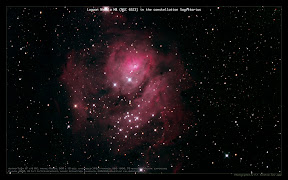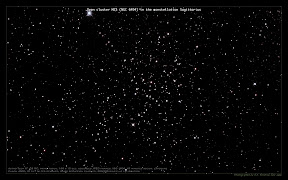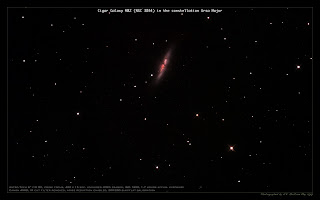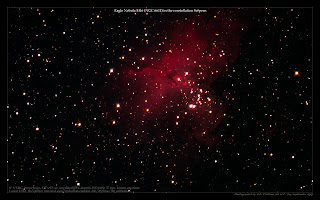I love storms.
I just don't love them when they interfere so well with my hobbies. So ready to try my filter experiment with new flats and darks.
Sigh.
It is going to be a long month.
Night Camera
Unguided astrophotography with a calculator and a beer
Live Star Chart -- Messier Slide Collection -- NGC Slide Series
Click here, to see latest weather radar Vail, AZ from Weather Underground
Get Polaris transit times at the U.S. Naval Oceanography Portal
Friday, July 27, 2012
Saturday, May 26, 2012
Focal reducer and AT8RC? Big deal.
There is a precept in astrophotography that should not be overlooked or ignored because some part of your brain is convinced a measure of counterbalance can be applied to the changing of things.
What is this astounding precept?
That for every new optical surface added into the optical train, the quantity of available photons is reduced.
Translation: the more optical junk you put in the way, the less light you are going to collect. Period.
Such is my experience with using a focal reducer with my telescope. Frankly, the output was less than I expected for the money spent. Though this attempt included a deep sky filter as well, the additional filter served to put an exclamation point on the less than fulfilling result.
Yes, the subject of this image is beautiful. That is God's handiwork, not mine. My contribution comprises the harsh cutoff of the darkness and less than brilliant stellar backdrop.
So in reducing the number of optical surfaces, choosing the filter over the focal reducer my choice. For those of you thinking about a focal reducer for your AT8RC, your time and money might be better spent simply focusing on increasing exposure and integration time.
...now, I just need to create some new darks and flats to go with this filter, and we shall see how things improve.
Saturday, January 28, 2012
It doesn't Bode well for the new flat...
This latest test of correcting the collimation of the AT8RC demonstrates that it will produce a virtually coma-free image as seen in the image of M81 (Bode's galaxy) below. This is good! However, I screwed up on creating the new flat. My white sheet apparently got loose and I left the camera on high gain (1600 ISO) rather than 100 ISO where it was supposed to be. Doh. Before post-processing, the imaged flat was not what I was expecting. Ran the image workflow anyway just to see. Need to remake the flat.
I suspect though it may not help much as that even with a marginally imaged flat, the previous addition of the field flattener had significant impact on post-processing out the uneven signal levels due to optical curvature.
So, before reverting back to using the flattener lens, I will take another round using a deep sky filter for comparison.
Labels:
AT8RC,
Bode's Galaxy,
deep sky filter,
field flattener,
flat,
M81
Thursday, January 26, 2012
Collimation step two...what step two?!
Waited almost an hour for scope to cool down outside this evening. For the optical star test, all the provided extension rings needed to be added including a 2" eyepiece extension. Three-star aligned scope using the 1.5" insert and both a 15mm and illuminated reticle piece. Tracked on Sirius to conduct test. It is a wonderfully clear night, again.
Looked just fine. Nice round concentric circles. No warping as focused in and out. Pin point focus also provided sharp diffraction spikes across the entire field of view. Very nice.
Started taking shots of M81 without the field flattener. Have to say, the brighter image seen in the test shots was pleasing. No filter either, we'll consider this a test run on the new collimation.
Need to remember to not remove camera until after I've been able to create a new flat with this change to the optical configuration
Looked just fine. Nice round concentric circles. No warping as focused in and out. Pin point focus also provided sharp diffraction spikes across the entire field of view. Very nice.
Started taking shots of M81 without the field flattener. Have to say, the brighter image seen in the test shots was pleasing. No filter either, we'll consider this a test run on the new collimation.
Need to remember to not remove camera until after I've been able to create a new flat with this change to the optical configuration
Sunday, January 22, 2012
AT8RC collimation, step one...
There are some frightening online postings regarding attempts by other users to collimate the AT8RC telescope. Hmmm. This does not sound good. So, I dug out and read the manufacturer instructions. My takeaway? DO NOT mess with the primary mirror screws! Check. From my readings, those who have, managed to truly make it worse and then spent many hours, days, and other tools to get it back. This should be simple, why is everyone making it sound so hard?
The Astro-Tech collimation instructions emphasize use of a Chesire eyepiece with a light source. This kind of eyepiece has a mirror with a center hole, and the mirror is tilted precisely in a 45 degree angle such that you can visually inspect the appearance of concentric rings with an external light source. Well, my vision ain't what it used to be, so I used my Orion LaserMate Deluxe collimator which is a chesire piece with a laser as your external light source. Brilliant. Much better than my visual acuity.
Removed the extension rings and put the focuser assembly directly to the back of the scope. Turned on the laser collimator. Surprise! The secondary was not in collimation. The return beam point was off center by at least one of the LaserMate's target rings. Out comes the Allen wrench. Took a few minutes to figure out the "loosen-tighten" pattern on the secondary adjustment bolts, then fairly quickly centered beam point and tightened alignment screws. Cool.
Next step in collimation, the star test. Results will be in the next post.
Clear Skies!
The Astro-Tech collimation instructions emphasize use of a Chesire eyepiece with a light source. This kind of eyepiece has a mirror with a center hole, and the mirror is tilted precisely in a 45 degree angle such that you can visually inspect the appearance of concentric rings with an external light source. Well, my vision ain't what it used to be, so I used my Orion LaserMate Deluxe collimator which is a chesire piece with a laser as your external light source. Brilliant. Much better than my visual acuity.
Removed the extension rings and put the focuser assembly directly to the back of the scope. Turned on the laser collimator. Surprise! The secondary was not in collimation. The return beam point was off center by at least one of the LaserMate's target rings. Out comes the Allen wrench. Took a few minutes to figure out the "loosen-tighten" pattern on the secondary adjustment bolts, then fairly quickly centered beam point and tightened alignment screws. Cool.
Next step in collimation, the star test. Results will be in the next post.
Clear Skies!
Close-up On Rosette Nebula
Near the center of the Rosette Nebula in the constellation Monoceros is an attractive open cluster. My daughter wanted another try at this deep sky object, after her first attempt a few years ago. I think we fared better this time, though still did not collect as many frames as we would have liked.
Nearly 400 frames from our new front driveway in the cul-de-sac. Given the amount of ambient light we had to deal with, I think it would be better to take this shot with a filter. Pushed post-processing on this one and added my own unsharp mask manually at the end.
Having second thoughts about continuing to use the field flattener. Why?! Well, the AT8RC is *supposed* to be largely coma free and the flattener is just another lense reducing transmission of photons in the optical chain. Was the field really that bad before? I don't recall. Maybe the RC scope needs colimation. When the image is finally processed, it is always cropped into my poster template. Wouldn't any aberrations in the outer field be removed? I recall images taken before the flattener were brighter. What about optical curvature? Well, calibrating each image frame with the flat takes care of that. Just need to create a new flat without the field flattener in place. Hmmmmm...haven't I been here before?
Saturday, December 31, 2011
Unguided Beauty
Incredible.
Noticed we had a surprising clear sky for once, even with a partial Moon approaching its first quarter in the Southwestern sky. Orion big and bold rising in the East, simply begged to photographed. Having little opportunity this year for much astrophotography, the prospect sounded wonderful to me.
Started snapping frames around 8pm, Moon set sometime after 11pm, and continued collecting frames until about 2am. Fantastic! A personal best, 458 unguided frames collected, just shy of 2 hours of effective exposure with the self-modified Canon 450D.
Actually, the nights activities produced over 500 frames, but after examing EACH one I had to throw out 50 due to undesirable motion effects...which is a bit on the high side. Not sure why. Temperature and slight wind maybe? Clumsy astrophotographer? Hmmm.
Wonderful thing about collecting more signal with the modified camera, the process provides more information to stretch out after the data fusion (preprocessing, aligning, stacking). A simple curve stretch after DDP processing and voila!
Sunday, June 26, 2011
Filaments in black and white, Veil Nebula
I don't usually post in black and white, but during post-processing I liked the look and feel of this.
A beautifully clear and dark evening afforded this fine take. Unlike star-forming emissive nebulae, the Veil Nebula is the diffuse remnants of a massive supernova. Dim nebula like this are difficult shots for a DSLR camera, even for a modified one as used in this photo. The image effectively comprises 75 minutes of exposure at ISO 1600. Something like this would make a great project over several nights to produce hours of exposure.
Technical bits: unguided, 300 x 15 sec. JPEG frames, 1600 ISO, modified Canon 450D, 200/200 bias/flat calibration, DDP post-processing, and slight color level adjustment. No stretching.
Technical bits: unguided, 300 x 15 sec. JPEG frames, 1600 ISO, modified Canon 450D, 200/200 bias/flat calibration, DDP post-processing, and slight color level adjustment. No stretching.
Friday, June 24, 2011
Hey! ...he's still alive.
Well, this certainly has been a long drought.
After moving in December, I misplaced my camera battery charger. Things went downhill from there. Once in a while I would think to myself, "...where is that d*#m charger?" Similarly, without much nightly goings on nothing happened with the blog.
In short, just a lot of life changes at once, and another big project occupies my evening pursuit. Finally, found the infernal battery charger this past weekend, and last night I was presented with a beautifully clear dark sky. Put the other on hold and started shooting. Need to get updated flats and bias, but a new image should be due, shortly.
Hello!
After moving in December, I misplaced my camera battery charger. Things went downhill from there. Once in a while I would think to myself, "...where is that d*#m charger?" Similarly, without much nightly goings on nothing happened with the blog.
In short, just a lot of life changes at once, and another big project occupies my evening pursuit. Finally, found the infernal battery charger this past weekend, and last night I was presented with a beautifully clear dark sky. Put the other on hold and started shooting. Need to get updated flats and bias, but a new image should be due, shortly.
Hello!
Thursday, September 16, 2010
Eagle Nebula with a friend...
My good friend Carl came down and spent an evening (and part of the early morning) with me walking through the paces of setting up the telescope and camera. We had a fantastic dark night, timing couldn't have been better for Carl. We spent much of our time catching up on old times and what's new, but we were able to stay focused enough, pardon the pun, to get a couple shots in.
We chose the Eagle Nebula (M16) first, even though we new it had already passed the meridian and was headed downward toward the West. We still managed to capture a fine picture. I'll post our other shot of Alnitak and the Flame Nebula soon, just being lazy.
We chose the Eagle Nebula (M16) first, even though we new it had already passed the meridian and was headed downward toward the West. We still managed to capture a fine picture. I'll post our other shot of Alnitak and the Flame Nebula soon, just being lazy.
Sunday, September 5, 2010
Bubble Nebula, NGC 7635
One last dim target before the stormy weather sets in again. Happy to present this more improved shot of the "bubble", an emission nebula in the constellation of Cassiopeia located near star 4 Cassiopeiae and open cluster M52.
Unguided, 400 x 15 sec. JPEG frames, 100 minutes of accumulated exposure, 1600 ISO, calibrated and such, processed with DDP. No stretching.
Unguided, 400 x 15 sec. JPEG frames, 100 minutes of accumulated exposure, 1600 ISO, calibrated and such, processed with DDP. No stretching.
Saturday, September 4, 2010
Eye of God
Nearly 400 exposures taken of the Helix Nebula in the constellation of Aquarius. This fascinating object is one of the closest planetary nebula to Earth, 700 light-years distant. I first heard of it on the Internet as the "Eye of God"...some silly news article. Had to check it out. Very dim, long exposures needed to detect that anything is there.
Unguided, 393 x 15 sec. JPEG frames, with DDP processing again. I've spent some time now using JPEG format to shorten and simplify the post processing. I think its given notable results. But, now that I've improved, it is probably time to work directly from RAW format. I'm sure I could do a much better job now with this new scope in pulling out detail.
Unguided, 393 x 15 sec. JPEG frames, with DDP processing again. I've spent some time now using JPEG format to shorten and simplify the post processing. I think its given notable results. But, now that I've improved, it is probably time to work directly from RAW format. I'm sure I could do a much better job now with this new scope in pulling out detail.
Friday, September 3, 2010
...when things go wrong
Not every shoot is easy. Things go awry, amiss, or just plain foobar. Below is an example of the Wrong Thing.
Yeah, so cool. Can you guess what the target might be? Bad tracking and a lack of attention to processing detail. Weeeee. This was supposed to have been a retake of the Trifid Nebula. Ahem.
Yeah, so cool. Can you guess what the target might be? Bad tracking and a lack of attention to processing detail. Weeeee. This was supposed to have been a retake of the Trifid Nebula. Ahem.
First light with AT8RC
First night out was a bit awkward, as my first target was cut short by some poor planning on my part. Had I realized before I started that the camera was going to travel right on into the tripod in just 100 or so frames, I would have just taken all the pictures on the other target. Honest, I wasn't drinking. Guess I was just a tad bit excited.
As such, 100 or so frames were certainly not enough to produce good results, but 200+ frames were just fine for a reshoot of the Pinwheel Galaxy, Messier 33 (M33).
Roughly half the diameter of our own Milky Way galaxy, M33 is a mere 3 million light years distant. Certainly nothing like "Five Million Years to Earth." This shoot was unguided, with 237 x 15 sec. JPEG frames, using a modified Canon 450D DSLR. Calibrated, stacked, DDP and unsharp mask applied using Nebulosity.
I love the improved magnification at prime focus with this scope...encourages me to go after some of the more smaller galaxies that I used to have second thoughts about.
As such, 100 or so frames were certainly not enough to produce good results, but 200+ frames were just fine for a reshoot of the Pinwheel Galaxy, Messier 33 (M33).
Roughly half the diameter of our own Milky Way galaxy, M33 is a mere 3 million light years distant. Certainly nothing like "Five Million Years to Earth." This shoot was unguided, with 237 x 15 sec. JPEG frames, using a modified Canon 450D DSLR. Calibrated, stacked, DDP and unsharp mask applied using Nebulosity.
I love the improved magnification at prime focus with this scope...encourages me to go after some of the more smaller galaxies that I used to have second thoughts about.
Monday, August 23, 2010
Taking it to the next level with the AT8RC...
It has arrived!
What a fine piece of Taiwanese machinery!
Balancing was quick and easy, using a recent replacement of the Atlas counterweight shaft with a 20" version from Criterion Machine Company of West Virginia. Replaced the stock focuser with my Moonlite version. The most excellent Moonlite focuser employs a shaft lock on the focuser knob rather than on the drawtube or drawtube rail, as compressing these induces unwanted image and focus shift. Had enough of that nonsense.
This week, evenings will be spent evaluating the back focus and adjusting the optical train configuration in preparation for the upcoming dark period. May the weather favor my intentions!
What a fine piece of Taiwanese machinery!
Balancing was quick and easy, using a recent replacement of the Atlas counterweight shaft with a 20" version from Criterion Machine Company of West Virginia. Replaced the stock focuser with my Moonlite version. The most excellent Moonlite focuser employs a shaft lock on the focuser knob rather than on the drawtube or drawtube rail, as compressing these induces unwanted image and focus shift. Had enough of that nonsense.
This week, evenings will be spent evaluating the back focus and adjusting the optical train configuration in preparation for the upcoming dark period. May the weather favor my intentions!
Sunday, August 22, 2010
Countdown to September dark skies
Nearing the end of the monsoon season with nine more days until the beginning of the next lunar dark cycle. Looking forward to good weather and clear skies!
Though the popular constellations for this period will be overhead, my attention will be a little to the east such that I can get sufficient exposures of deep sky objects throughout the evening. The regions of celestial interest in this September shoot being the constellations of Sagittarius, Capricornus, Pegasus, and Cygnus.
Though the popular constellations for this period will be overhead, my attention will be a little to the east such that I can get sufficient exposures of deep sky objects throughout the evening. The regions of celestial interest in this September shoot being the constellations of Sagittarius, Capricornus, Pegasus, and Cygnus.
Thursday, August 19, 2010
A new look!
A little extra time on my hands; trying out the new eBlogger template designer. Nice. I like the change. Hope you do, too.
Tuesday, July 6, 2010
Messier 8, the Lagoon Nebula remix
Okay, once again trying my hand at this beautiful deep sky object. Of all my shoots, this has seemed to be the most troublesome; my recent attempts thwarted by cloud pirates and processing gremlins. This time the odds are better with significant improvements:

You be the judge. 300 x 15-sec. unguided JPEG frames, nearly 75 minutes of overall exposure, modified-Canon XTi, field flattener, calibrated, and processed with DDP.
- polar alignment using setting circles and computed transit time
- better dynamic range and less noise than previous DSLR
- IR-cut filter removed
- field flattener lens adapter
- images normalized prior to stacking
- new DDP algorithm rather than traditional "stretching"
- nearly doubled the number of exposures taken

You be the judge. 300 x 15-sec. unguided JPEG frames, nearly 75 minutes of overall exposure, modified-Canon XTi, field flattener, calibrated, and processed with DDP.
Monday, July 5, 2010
Messier 23
Back in Tucson under a beautiful night sky for the Fourth of July! Here is Messier 23, an open cluster in the constellation of Sagittarius; one more in my quest to capture every Messier object.

This is very close, cosmologically speaking, only a couple thousand light-years away and upwards of 20 light-years across. Taken with DSLR @ 1600 ISO, unguided, 190 x 15 sec. JPEG frames, calibrated 200/200 bias/flat, and finished processing without "stretching". Instead, out of curiosity, the Digital Development Processing (DDP) feature of Nebulosity was used.
From what I've read, DDP makes digital images more like film and was invented by Kunihiko Okano, a physicist and amateur astronomer. I compared my results with some manual stretching and found I preferred the DDP output. Threw in a some sharpening and color balance - voila.

This is very close, cosmologically speaking, only a couple thousand light-years away and upwards of 20 light-years across. Taken with DSLR @ 1600 ISO, unguided, 190 x 15 sec. JPEG frames, calibrated 200/200 bias/flat, and finished processing without "stretching". Instead, out of curiosity, the Digital Development Processing (DDP) feature of Nebulosity was used.
From what I've read, DDP makes digital images more like film and was invented by Kunihiko Okano, a physicist and amateur astronomer. I compared my results with some manual stretching and found I preferred the DDP output. Threw in a some sharpening and color balance - voila.
Sunday, May 16, 2010
Messier 82, Cigar Galaxy
A new personal record, 400 frames! The whole lot taken in just under 5 hours during a good night of extended darkness. This galaxy gets its unusual shape from an exceptionally high rate of star formation, a process called starburst [wiki].

To add to this one's mystery, in April of this year, radio astronomers in Manchester reported a strange new object in M82. A 'micro quasar' was suggested, highly luminous and fairly stable. Some associate this with a massive black hole system, but not at the galaxy's center. The object is several arcseconds off center and an apparent motion of 4x the speed of light!
Yes, you read right, FOUR times the speed of light....warp speed, Scotty!

To add to this one's mystery, in April of this year, radio astronomers in Manchester reported a strange new object in M82. A 'micro quasar' was suggested, highly luminous and fairly stable. Some associate this with a massive black hole system, but not at the galaxy's center. The object is several arcseconds off center and an apparent motion of 4x the speed of light!
Yes, you read right, FOUR times the speed of light....warp speed, Scotty!
Subscribe to:
Comments (Atom)











